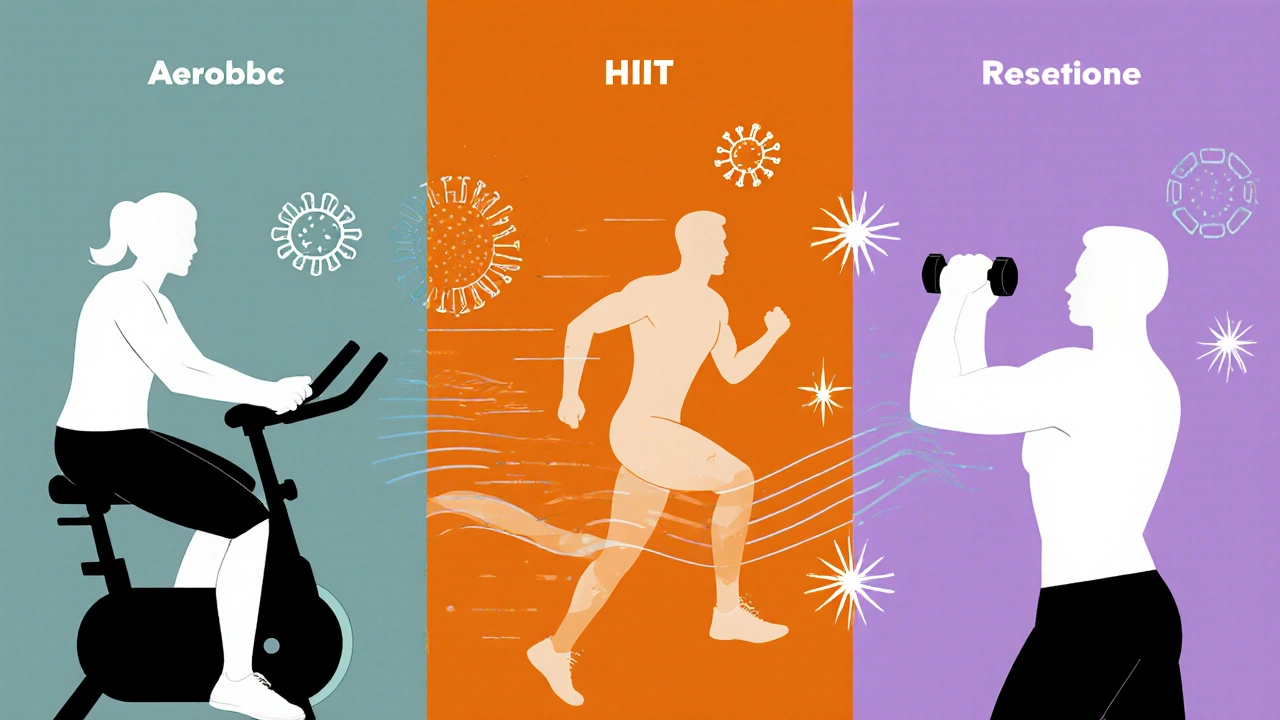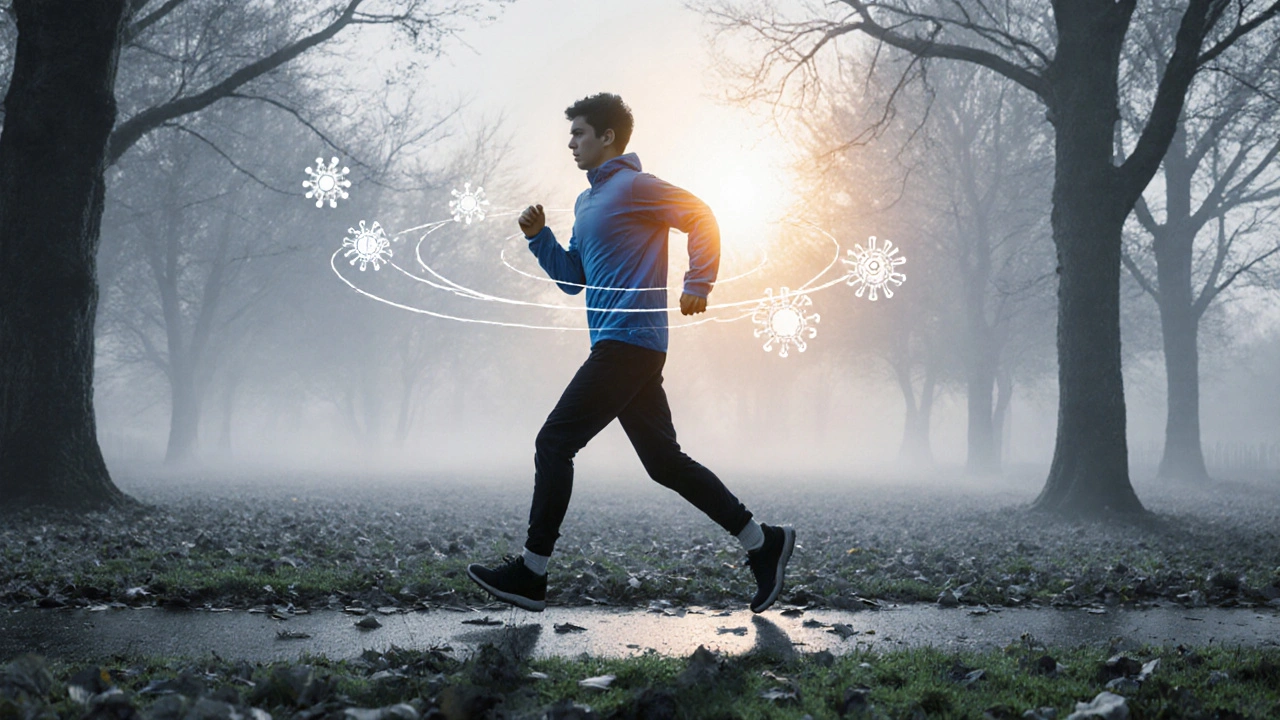Immune-Boosting Exercise Calculator
Calculate Your Immune Benefits
Determine if your exercise routine is optimally boosting your immune system based on the latest science.
Results
Ever wonder why a brisk walk feels like a natural “reset” after a cold season? That feeling isn’t just in your head - it’s your body’s exercise and immunity connection kicking in. Regular movement doesn’t just tone muscles; it acts like a rehearsal for your immune troops, keeping them sharp, mobile, and ready for battle. Below you’ll learn exactly how physical activity bolsters your defenses, which workouts work best, and how to avoid the rare but real risk of overtraining.
Key Takeaways
- Moderate aerobic exercise boosts white‑blood‑cell circulation and improves vaccine response.
- Both intensity and duration matter - 150minutes of moderate activity or 75minutes of vigorous activity per week is the sweet spot.
- High‑Intensity Interval Training (HIIT) can enhance immunity if kept short (<30min) and paired with adequate rest.
- Overtraining raises stress hormones, suppresses cytokine production, and can increase infection risk.
- Combine exercise with good sleep, balanced nutrition, and hydration for maximum immune support.
How Exercise Affects the Immune System
When we talk about Exercise is a planned, structured, and repetitive bodily activity aimed at improving or maintaining physical fitness, the immediate benefit is better blood flow. Faster circulation means immune cells, especially White Blood Cells, can patrol the body more efficiently, spotting viruses and bacteria before they settle in.
Beyond logistics, exercise tempers the release of Stress Hormones like cortisol. Short‑term spikes during a workout mobilize energy, but chronic elevation suppresses immunity. A regular routine keeps cortisol in check, allowing Cytokines - the signaling proteins that coordinate immune responses - to function without interruption.
Physical activity also stimulates the production of Antibodies. Studies on older adults show that a 12‑week moderate‑intensity program increased antibody titers after flu vaccination by up to 40% compared with sedentary peers.
Best Types of Exercise for Immunity
Not all workouts are created equal in the eyes of the immune system. Here’s a quick rundown:
- Moderate Intensity (e.g., brisk walking, light cycling) - enhances immune surveillance without stressing the body.
- High‑Intensity Interval Training (HIIT) - short bursts can spike natural killer cell activity, but only when total session time stays under 30minutes.
- Resistance training - improves muscle mass, which indirectly supports immune health by reducing chronic inflammation.
| Exercise Type | Typical Duration | Immune Benefit | Potential Risk |
|---|---|---|---|
| Moderate Aerobic | 30-60min | Increased circulation of white blood cells, higher vaccine response | Low |
| Vigorous Aerobic | 20-45min | Boosted natural‑killer cell activity | Moderate if done >5days/week |
| HIIT | 10-30min | Transient spike in cytokine production, enhanced antibody response | Overtraining if >3sessions/week |
| Resistance | 30-45min | Reduced chronic inflammation, better metabolic health | Injury risk if technique is poor |

Practical Guidelines to Get Immune‑Boosting Benefits
- Frequency: Aim for at least five days a week of moderate activity or three days of vigorous activity.
- Duration: 150minutes of moderate or 75minutes of vigorous exercise per week, broken into manageable sessions.
- Intensity: Use the talk test - you should be able to speak in short sentences during moderate activity.
- Mix It Up: Combine aerobic work with two strength‑training sessions to cover all immune‑supporting pathways.
- Recovery: Schedule at least one full rest day and incorporate light stretching or yoga to lower cortisol.
Following these steps keeps the immune system in a “readiness” mode without tipping into the stress zone that can suppress defenses.
Common Pitfalls and How to Avoid Overtraining
While exercise is a potent immune ally, too much can backfire. Persistent high‑intensity sessions without adequate recovery raise Chronic Inflammation, which weakens the body’s ability to fight off infections.
Signs you’re overdoing it include prolonged fatigue, sleep disturbances, and a higher frequency of colds. If you notice these, dial back intensity, add extra rest days, or swap a hard session for a low‑impact activity like walking.

Supporting Lifestyle Factors
Exercise works best alongside other immune‑friendly habits.
- Sleep: Aim for 7-9hours nightly; deep sleep restores cytokine balance.
- Nutrition: Foods rich in vitaminC, zinc, and omega‑3 fatty acids provide the building blocks for antibodies.
- Hydration: Staying well‑hydrated ensures lymph fluid flows smoothly, carrying immune cells throughout the body.
Think of your health as a symphony - exercise is the rhythm section, but sleep, food, and water are the melody and harmony that keep everything in sync.
Frequently Asked Questions
Can a single workout improve immunity?
Yes. Even a 20‑minute brisk walk can increase the circulation of immune cells for several hours post‑exercise.
Is HIIT safe for older adults?
When supervised and kept short (10‑15minutes), HIIT can boost immune function in seniors without excessive strain.
How long does the immune boost last after exercising?
The heightened activity of white blood cells typically peaks 2‑3hours after a session and can stay elevated for up to 24hours.
What signs indicate I’m overtraining?
Frequent colds, lingering muscle soreness, irritability, and trouble sleeping are red flags that you need more recovery.
Does exercise affect vaccine effectiveness?
Studies show that people who engage in regular moderate exercise develop stronger antibody responses to flu and COVID‑19 vaccines.


Yo, get moving! A daily 30‑minute brisk walk isn’t just a mood booster, it actually spikes your white‑blood‑cell traffic, priming your immune battalion for anything that tries to invade. Think of it as a weekly drill that keeps your defenses on their toes, and you’ll notice fewer sick days. Keep the intensity moderate-talk test level-and you’ll stay in the sweet spot where cortisol stays low and immunity rises.
I’ve been swapping the couch for quick evening strolls and honestly feel more resilient during flu season. The gentle rhythm keeps my breathing steady and my mind clear, which feels like a natural vaccine boost. Plus, it’s low‑impact, so I never risk the overtraining pitfall.
Regular physical activity triggers a cascade of physiological events that collectively enhance immune surveillance.
During moderate aerobic exercise, the heart pumps blood faster, which shuttles immune cells like neutrophils and NK cells through the vascular network more efficiently.
These cells spend less time lingering in lymph nodes and more time patrolling peripheral tissues where pathogens are likely to appear.
The mobilization is driven by catecholamines such as epinephrine that surge with each bout of movement.
Once the workout ends, the catecholamine levels gradually decline, allowing the immune cells to settle back into their normal circulation patterns without staying over‑activated.
This transient boost lasts roughly two to three hours post‑exercise, aligning perfectly with the window when many people report feeling less prone to catching a cold.
If you repeat moderate sessions several times a week, the cumulative effect is a more vigilant immune system that responds faster to infections.
Moreover, regular training improves the body’s anti‑inflammatory cytokine profile, reducing chronic low‑grade inflammation that can blunt immune function.
Studies have shown that participants who adhered to the WHO recommendation of 150 minutes of moderate activity per week had higher antibody titers after flu vaccination compared to sedentary controls.
High‑intensity interval training, when kept brief and spaced appropriately, can further amplify these benefits by inducing brief spikes in interleukin‑6 that stimulate antibody production.
However, the same HIIT stimulus can become detrimental if you push beyond three sessions per week without sufficient recovery, leading to cortisol‑mediated immunosuppression.
Resistance training adds another layer by increasing muscle mass, which serves as a reservoir for glucose and amino acids needed for optimal lymphocyte function.
Adequate protein intake post‑workout supports this process, ensuring that repair mechanisms do not divert resources away from immune cells.
Finally, integrating active recovery such as yoga or light walking helps normalize heart rate variability, a marker linked to better immune regulation.
In short, a balanced mix of aerobic, strength, and recovery work creates a synergistic environment where the immune system operates at peak readiness without tipping into stress overload.
Don’t mistake a weekend heavy‑lift session for a daily health miracle.
I like the practical tip about using the talk test it makes it easy to gauge intensity without fancy gear plus a rest day every week keeps cortisol low enough to avoid burnout
While the presented data are compelling, one must consider the heterogeneity of study populations, as extrapolation to all age groups remains speculative.
Exercise is the true patriotism of the body 💪🇮🇳
Great point about study variability – in fact, the recent meta‑analysis stratified results by age and found that seniors still gain a measurable vaccine boost from moderate walking, albeit with a slightly lower magnitude than younger adults.
Sure, exercise helps, but the real immune boost comes from the hidden micro‑chips they’re putting in the water supply.
Ignore that nonsense, the only thing that matters is crushing your cardio limits and showing the system who's boss.